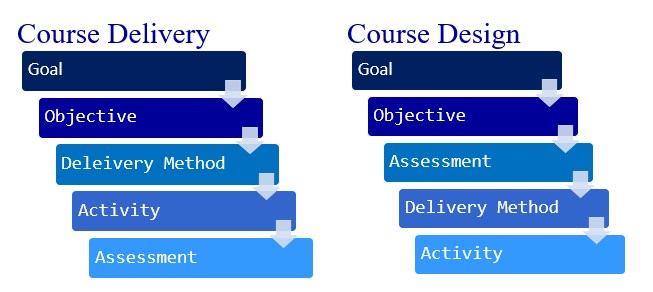Course Alignment
Course alignment is essential for an effective learning course. Alignment refers to the connection between course goals, objectives, instruction, activities, and assessments. If a course is properly aligned, it means the goals and objectives are directly related to the instruction, activities, and assessments. Proper alignment helps ensure that what is taught and practiced in the course will allow the learner to successfully perform the necessary tasks required by the job functions.
Elements in Course Alignment:
- Competencies
- Learning goals
- Learning objectives
- Activities
- Assessments
- Instructional methods and strategies
Starting with the End in Mind
To ensure course alignment, start with the end in mind. Courses are designed by working backwards from desired results to method of instruction. Therefore, you must first determine what the learner needs to know or do at the completion of the course. These are the competencies.
Competencies are arrays of the essential knowledge, skills, and abilities (KSAs) required to achieve an acceptable level of performance. Therefore, when determining competencies for a course, determine and describe the desired knowledge and abilities needed to perform the tasks.
Once the desired competencies are identified, the next piece for correct alignment is defining a learning goal for the course. A learning goal broadly describes the desired knowledge, skills, and abilities (KSAs) a participant needs to successfully perform at the completion of the course.
The competencies are about what the individual will need to be able to do after the course to perform his or her job functions, whereas the learning goal is what the individual should learn in the course. The goal is a broad statement about the competencies the learner will gain from attending the course. It provides direction and a point of reference for the course instruction and activities. All course instructions, activities, and assessments should be aligned to the goal.
Creating Learning Objectives
To ensure proper alignment, after the learning goal is defined, the next step is to determine the learning objectives. Objectives are established by unbundling the desired competencies into their basic parts to determine what the participant would need to know to perform this competency at a specific level. These objectives are the measurable indicators of what the learner is expected to demonstrate upon course completion.
To ensure proper alignment ask; “What do the learners need to know how to do when they leave this course?”
Assessments
Once learning objectives are established, the next step is to create assessments that will allow you to determine if learners have accomplished the learning objectives.
Assessments are a mechanisms for collecting evidence that the learners have met the learning objectives. It is basically a test to verify the learner is able to apply what they have learned in the session. It helps to confirm that the course has met it intended goal.
To ensure proper alignment with the objectives ask; “What kinds of tasks will reveal whether the learners have achieved the learning objectives?”
Instructional Methods and Strategies
The next step in aligning a course is to determine the most effective ways to communicating and imparting the new information to the learner. This can be accomplished various different ways including lecture, demonstration, group discussion, and case study.
To ensure proper alignment with the assessments ask; “What does the learner need to know to successfully on the assessments?”
Activities
The final step in the alignment is the creation of activities that allow the learner to practice applying the new skills and knowledge. The activities should support the instructional methods and prepare the learner for the assessments. All activities should involve an element of feedback to help the learners apply the information correctly and be successful with the assessments afterwards.
To ensure proper alignment with the instructional methods ask; “What kinds of activities will allow the learner to demonstrate what they have gained from the instruction and prepare them for the assessments?”
Summary
Linking teaching methods and learning activities, to assessments, to learning objectives, and ultimately to course learning goals will help ensure the intended learning takes place. All these elements need to be closely aligned so that they reinforce one another. If the learning objectives, activities, instruction, and assessments are not in alignment the course may be disorganized and ineffective.
Related Links
Learning goals, objectives, and outcomes
Competencies and Learning Objectives
Learning Goals and Learning Objectives
Components Learning Objectives


